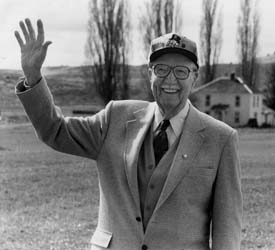

 The Golden Years of Disney's Ducks There is something immensely attractive about the past, something that brings out the collector in all of us. Across a haze of years, the good old days really do look good. If we could catch a moment and frame it, we might be able to preserve that feeling, might hold on long enough to keep the present at bay. This is what the paintings of Carl Barks are about. Barks never destined himself for a painter. He took up the brush first as a distraction in the 1950s, then as a hobby after retiring from a long career in cartooning. For those who haven't heard, he is the man who drew Walt Disney's duck comics for twenty-five years, creating Uncle Scrooge and giving Donald a depth of personality that the character never enjoyed on the screen. His stories have a ring of truth and a special wistfulness, for they draw on events from the artist's youth and motifs culled from mankind's youth. When Donald fails at a task or Scrooge triumphs, it's Barks we are watching; and when the ducks raid a hoard of Greek coins or Persian carvings, it's still Barks, extending his nostalgia through the centuries. For all their modern cynicism, his tales portray a world that was bold and beautiful, whether in the temples of Sparta or the heart of America's farmland. Barks retired in 1966. Both his fans and his editors grumbled, but the fans did something about it: they petitioned the artist to undertake a series of paintings based on his comics. At first Barks was skeptical. He had been painting in oils--dabbling, really--only four years. The project involved rethinking his graphics and immersing himself seriously in a new medium. But he took to it like a duck to water, and the fans were jubilant. Here at last, in heavy gilt frames, were moments from the past, from the comics they had read as children. Better yet, they could participate in the process of enshrining these moments, for Barks accepted commissions on specific subjects. It was like Donald's wildest dream come true, a chance at your own tiny corner of heaven. In 1982 Barks began a second series of oils to be printed as limited-edition lithographs by Another Rainbow, a fan publisher that owes its name and its success to the ducks. If Donald was guiding the first venture, Scrooge is the spirit behind the later paintings, for prices have accelerated in the last fifteen years, bringing a contingent of rich investors into the market. Now the treasure caves and money bins assume a new significance. Like Scrooge's dollars, they are not just souvenirs of the past, but romantic emblems of the owner's spiritual and financial worth. Hang a Barks painting on your wall, and you will be saying to the world, "This is what I am." That's what collecting has always been about. So take a moment to look over the paintings of Carl Barks. Long-time fans will recognize favorite scenes from the comics, while newcomers will enjoy a different kind of nostalgia in the vintage cars and holiday tableaux. There is even a rocket ship that might have burst from the pages of Flash Gordon. It's Scrooge, however, who dominates these pictures, scrimping, saving, adventuring, and above all collecting. Make no mistake, this golden age was truly golden. Copyright ©
1992 by Geoffrey Blum |
|
|||||
Copyright © 2003 by Geoffrey Blum